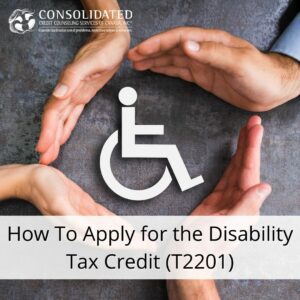Forget pay equity; for many people with a disability, just living at the poverty line feels like a pipe dream. We’re not talking about a small population of people. The Disability Poverty Report Card (DPRC) says that over one in four (27%) Canadians has a disability. One in six of those people lives below the poverty line. That’s over 1.5 million of our most vulnerable population living in poverty. Many more, while not below the poverty line, are just squeaking by.
These people often rely on debt to close the gap so they can simply put food in their stomachs and a roof over their heads. This debt can quickly become unmanageable and make their situation even more precarious. Frequently, this added stress exacerbates their health situation, making things even more difficult.
Causes of debt
More expenses
People with disabilities typically have more expenses in the form of medical aids, medicine, and treatments. These costs add up quickly. Often, these costs aren’t covered by health insurance as much, or as frequently, as most people assume.
Fewer job opportunities
Many people with disabilities are able to work to some degree. In fact, they’re craving to work. They want and deserve the satisfaction of a job well done, to be entrusted with the responsibilities they’ve earned, and to be included in the community. The lucky ones that have a job work hard! The issue is that many find it difficult to even get in the door. Figuratively and literally.
Those with disabilities encounter many barriers when it comes to work life. Disabilities tend to come with the need for time off for appointments or to manage symptoms in a healthy way. They find it difficult to find workplaces that are flexible and understanding of those needs. Physical barriers like stairs and inaccessible washrooms are also an issue. Companies hesitate to hire those with disabilities out of concern about the cost of adapting the office space to accommodate their needs. This is even though most adaptive measures only cost, at most, a few hundred dollars.
Though it is unlawful for these barriers to prevent a person with a disability from being hired, they still do. Leaving many unemployed.
Pay disparity
The sad part is that those with disabilities lucky enough to find work are frequently not paid nearly as much as their able-bodied counterparts.
Stats
Below are a few eye-opening statistics about people with disabilities.
- On average, pay equity is so off balance that those with disabilities would need a 30% increase in income just to meet the poverty line.
- Women with disabilities are almost 13% more likely to live in poverty than men with disabilities.
- Those 65 and above with disabilities are almost 20% more likely to live in poverty compared to those under 65.
- 16.8% of people with disabilities, compared to only 9.3% of able-bodied people, live below the poverty line.
- When comparing socio-economic demographics, women faired worse than men across the board.
- Provincially funded disability support was the furthest below the poverty line in Nunavut, New Brunswick, and Nova Scotia. Only the Northwest Territories come close to the poverty line.
- No matter the race, those with disabilities are 20% more likely to be unemployed than their able-bodied counterparts.
- According to Wealth Professional, those with cognitive disabilities are worse off, earning only 46.6% of those without disabilities. Those with mental health-related disabilities earn 31.0% less, physical disabilities 20.7% less and sensory disabilities 12.3% less than their able-bodied counterparts.
Debt solutions for people with disabilities
There’s virtually no difference between what debt relief solutions are offered for those living with a disability compared to others. The main mitigating factor is income. Some debt solutions require a minimum amount of disposable income so payments can be made reliably. This makes pay equity a big issue when it comes to debt. Statistically, those with a disability earn less, which may mean being eligible for fewer debt management options. That being said, even an able-bodied person in the same financial situation would face the same challenges. Below are some of the most common debt management solutions.
It may be a relief to know that any funds contributed to a Registered Disability Savings Plan within the 12 months before starting any debt solution plan cannot be touched. Thankfully, critical disability assets like mobility and health equipment cannot be seized.
Programs, organizations, and services that help people with disabilities
Government Assistance
Canada Disability Savings Grant (CDSG) – A grant that matches up to $70,000 contributed toward the Registered Disability Savings Plan (RDSP).
Canada Disability Savings Bonds (CDSB) – Each eligible low-income individual can receive up to $20,000 in government deposits.
Registered Disability Savings Plan (RDSP) – This is similar to a Registered Retirement Savings Plan (RRSP), but specifically for those with disabilities. While not specifically for retirement, it is a long-term savings option. This does come with a lifetime contribution limit of $200,000.
Provincial disability support programs – Each province and territory has a program geared at supporting those with disabilities. Each one is different, but most offer financial assistance, health benefits, and employment support.
Disability Tax Credit (DTC) – The DTC reduces the tax burden of those with physical and mental disabilities. It is a non-refundable tax credit.
Canada Disability Benefit (CDB) – The CWB is a very controversial benefit. Before details were announced, the disabled community had high hopes that they would get more help. Once details were released, the community was sorely disappointed. As of now, this benefit offers up to $200 a month for those eligible. The controversial part of this is that this still leaves many far below the poverty line. There are also still questions around whether partaking in the CWB will mean claw backs other benefits, making this benefit worth even less.
Organizations
- Prosper Canada
- AMI
- Canadian Disabilities Resources Society
- Council of Canadians with Disabilities
- Inclusion Canada
Wrap up
The discussion around finances and disabilities is complicated. One part of it that the numbers make clear is that, even with the support available, the majority of those with disabilities still struggle financially.
Helping the disabled community out of compassion is great, but there’s another part of the discussion that many people don’t realize. Most people, as they age, at one point in their lives or another will, at the very least, be temporarily disabled. It only makes sense for businesses and currently able-bodied people to stay informed and advocate.
If you are one of these people and are struggling with unmanageable debt our Credit Counsellors can help. During a free consultation they’ll work with you to understand what debt-relief programs are available and which one is right for you.




